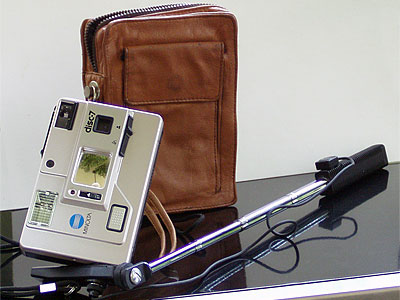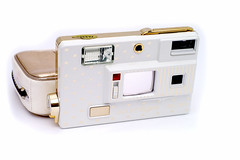Difference between revisions of "Minolta Disc-7"
m (→Links) |
m (minor links) |
||
| Line 5: | Line 5: | ||
|image_text= Disc-7 | |image_text= Disc-7 | ||
}} | }} | ||
| − | The '''Minolta Disc-7''' was one of the better cameras designed for [[disc film]]. In common with other disc cameras, the [[Minolta]] had a flat, compact design, but a limited range of photographic features. The lens was fixed-focus, although it had a macro mode, and there were just two shutter speeds. | + | The '''Minolta Disc-7''' was one of the better cameras designed for [[disc film]]. In common with other [[:Category: Disc film|disc cameras]], the [[Minolta]] had a flat, compact design, but a limited range of photographic features. The lens was [[fixed-focus]], although it had a [[Lens#Macro|macro mode]], and there were just two shutter speeds. |
The Disc-7 had one remarkable feature which stood it apart from other disc cameras. In the center of the front plate was a small convex mirror, which could be used by the photographer to compose a self-portrait. The tiltable, telescoping carrying strap was used as a focusing aid, as its length corresponded with the optimal focus distance of the macro lens - a similar focusing system was later used by [[Olympus]] for the [[Olympus XA4]] Macro. | The Disc-7 had one remarkable feature which stood it apart from other disc cameras. In the center of the front plate was a small convex mirror, which could be used by the photographer to compose a self-portrait. The tiltable, telescoping carrying strap was used as a focusing aid, as its length corresponded with the optimal focus distance of the macro lens - a similar focusing system was later used by [[Olympus]] for the [[Olympus XA4]] Macro. | ||
| Line 13: | Line 13: | ||
* Manufacturer: [[Minolta]] | * Manufacturer: [[Minolta]] | ||
* Year of release: 1983 | * Year of release: 1983 | ||
| − | * Films: [[disc film]] with speed 200 ASA | + | * Films: [[disc film]] with speed 200 [[ASA]] |
* Lens: 1:2.8/12.5mm | * Lens: 1:2.8/12.5mm | ||
* Shutter: speeds 1/100 and 1/200 sec. | * Shutter: speeds 1/100 and 1/200 sec. | ||
* Aperture: [[CdS|CdS-controlled]] | * Aperture: [[CdS|CdS-controlled]] | ||
| − | * Self-timer: with control LED | + | * [[Self-timer]]: with control [[LED]] |
* Flash: guide number 9 | * Flash: guide number 9 | ||
| − | * | + | * Weight: 200g |
* dimensions: 129.5×78×21mm | * dimensions: 129.5×78×21mm | ||
* Power: lithium batteries which have to be replaced by the manufacturer | * Power: lithium batteries which have to be replaced by the manufacturer | ||
Revision as of 22:51, 7 January 2010

|
| Disc-7 |
The Minolta Disc-7 was one of the better cameras designed for disc film. In common with other disc cameras, the Minolta had a flat, compact design, but a limited range of photographic features. The lens was fixed-focus, although it had a macro mode, and there were just two shutter speeds.
The Disc-7 had one remarkable feature which stood it apart from other disc cameras. In the center of the front plate was a small convex mirror, which could be used by the photographer to compose a self-portrait. The tiltable, telescoping carrying strap was used as a focusing aid, as its length corresponded with the optimal focus distance of the macro lens - a similar focusing system was later used by Olympus for the Olympus XA4 Macro.
Specs
- Type: compact camera
- Manufacturer: Minolta
- Year of release: 1983
- Films: disc film with speed 200 ASA
- Lens: 1:2.8/12.5mm
- Shutter: speeds 1/100 and 1/200 sec.
- Aperture: CdS-controlled
- Self-timer: with control LED
- Flash: guide number 9
- Weight: 200g
- dimensions: 129.5×78×21mm
- Power: lithium batteries which have to be replaced by the manufacturer

|
| ac 301 Courrèges |
The Minolta ac 301 Courrèges was designed in conjunction with French fashion house André Courrèges.[1] It carried the Courrèges logo, with a cream-white front, a gold-coloured frame, and an attractive soft case. A similar exercise was carried out with the Minolta Disc-5, which became the Minolta ac 101 Courrèges.
Links
- Minolta Disc 7 on www.collection-appareils.fr by Sylvain Halgand